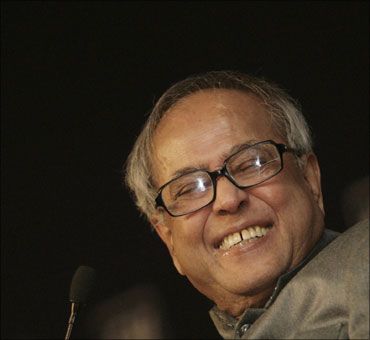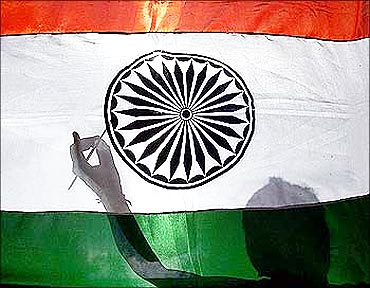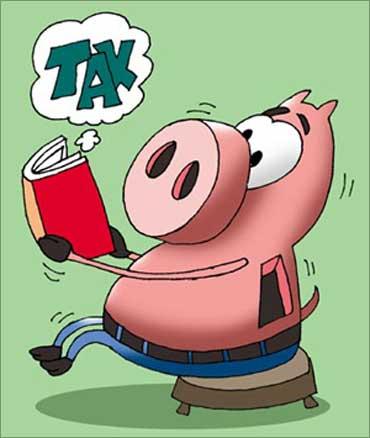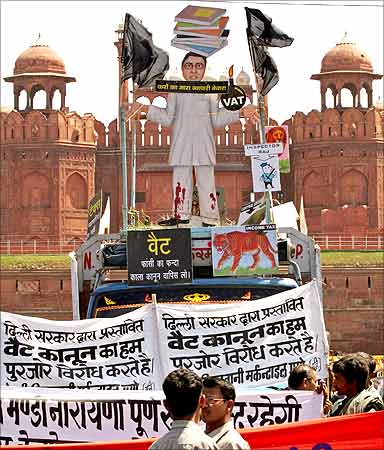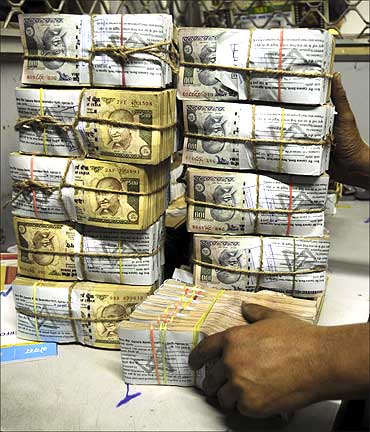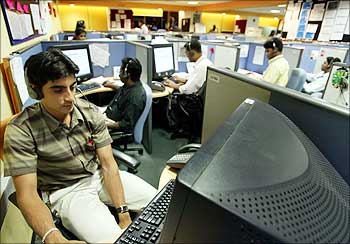 | « Back to article | Print this article |
How Budget may affect income tax, industry sectors
The Union Budget for 2011-12 comes at a critical juncture for the economy -- high inflation, tight liquidity, elevated fiscal and current account deficits, and a slowdown in the reform process have taken away the sheen from the India growth story, says global investment banking and securities major Goldman Sachs in a research paper jointly authored by Tushar Poddar and Vishal Vaibhaw.
Potentially, the Budget provides an opportunity to move towards fiscal consolidation and to make a bold statement on reform.
However, there are strong reasons which could prevent such a move -- state elections in 5 states over the summer, elevated inflationary pressures, and governance issues.
Moreover, this is a mid-term Budget, and with key tax reforms such as the GST and direct tax code a year away, and Goldman does not think there will be many surprises in the Budget.
Click NEXT to read on . . .
How Budget may impact taxes, industry sectors
India will present its annual Union Budget on February 28. Market participants will be keenly watching the government's fiscal deficit numbers, and any significant reforms.
In terms of specific measures, on the taxation side, Goldman expects some broad-basing of the service tax, higher income tax exemptions, and a possible increase in excise duties on autos.
On the expenditure side, it expects the Budget to have increases in food subsidies and National Rural Employment Guarantee Act, along with a continued increase in outlays on infrastructure.
Click NEXT to read on . . .
How Budget may impact taxes, industry sectors
Tax proposals
The Budget may contain the following tax changes which would overall be revenue positive:
- Income tax relief can be provided to lower income brackets to compensate for inflation.
- This could take the form of raising the tax exemption limit from the current 160,000.
- Excise duty on automobiles could be raised to 12% from 10%, rolling back the stimulus given during the financial crisis.
- The tax base for the service tax will likely be expanded by including health and education services within its ambit.
- Export duties on iron ore may be increased, as could excise taxes on tobacco companies.
- Incentives for greater foreign investment in corporate bonds by reducing the withholding tax on interest income to 10% from 20%.
Click NEXT to read on . . .
How Budget may impact taxes, industry sectors
Expenditure proposals
The National Rural Employment Guarantee Act (NREGA) could see a substantial increase in outlay. Goldman estimates the Budget could make a provision of Rs 64,000 crore for the NREGA in 2011-2012, against Rs 40,100 crore in the current fiscal year.
Food subsidy bill may be increased, especially given the higher food prices.
The government has planned to free urea prices under the Nutrient-based Subsidy policy regime, and as a result, could raise urea prices in the Budget. This would help reduce fertilizer subsidies.
Click NEXT to read on . . .
How Budget may impact taxes, industry sectors
Reforms
Market participants are looking for reforms in the areas of FDI in retail, a firm date for the GST, speedier resolution of land acquisition issues, and reducing fertilizer subsidies.
Any developments on these fronts could be seen as a positive.
However, given the challenges in front of the government, we do not envisage a major reform push in the Budget.
Click NEXT to read on . . .
How Budget may impact taxes, industry sectors
Reforms
Market participants are looking for reforms in the areas of FDI in retail, a firm date for the GST, speedier resolution of land acquisition issues, and reducing fertilizer subsidies.
Any developments on these fronts could be seen as a positive.
However, given the challenges in front of the government, we do not envisage a major reform push in the Budget.
Click NEXT to read on . . .
How Budget may impact taxes, industry sectors
Fiscal deficit
Goldman expects the central fiscal deficit for FY11 to come in at 4.9% of GDP largely due to the windfall on 3G telecom auctions and privatisation proceeds.
For FY12, even with revenue measures and slower growth in expenditures, Goldman expect the central deficit to be slightly higher at 5.0% of GDP, largely as the one-off revenues would be considerably reduced.
Goldman says that the overall fiscal consolidation could impart a negative fiscal impulse after 3 years of positive impulse. The investment banking major thinks the risks to the deficit target are skewed to the upside due to continued spending pressures on food and fuel subsidies.
It believes the government could announce market borrowings of around Rs 3.8 trillion ($80 billion), which would be significantly higher than the borrowings in FY11, and thinks that on balance, this could be negative for government bonds.
Click NEXT to read on . . .
How Budget may impact taxes, industry sectors
Fiscal consolidation sans 3G?
The primary focus of the Budget remains how much the government can reduce its market borrowing, says Goldman.
In 2010-2011, the deficit was buoyed by one-off items -- the much-larger-than expected 3G and BWA telecom auctions (Rs 106,000 crore), privatisation (Rs 22,700 crore), and higher nominal GDP growth.
Including these, Glodman believes the central deficit could end at 4.9% of GDP, much lower than the budgeted figure of 5.5% of GDP. However, if one excludes the one-off items from telecom and privatisation, then the deficit could rise to 6.7% of GDP, feels Goldman.
For FY12, Goldman expects fiscal deficit to remain at 5.0% of GDP including privatisation and additional telecom receipts. Without these, however, the deficit could come in higher at 5.5% of GDP.
Yet, this can constitute some fiscal consolidation through higher revenues and current expenditures growing slower than nominal GDP.
Click NEXT to read on . . .
How Budget may impact taxes, industry sectors
Goldman's fiscal impulse estimates, which measure how much stimulus fiscal policy is providing to the economy, suggest that the government impulse could be negative for FY12, if there is indeed the fiscal consolidation that we expect in the budget.
In FY11, the fiscal impulse was essentially zero excluding the telecom and divestment proceeds.
In terms of market borrowing, the securities firm thinks that the government's net market borrowing could be higher at Rs 3.8 lakh crore ($80 billion), compared to a projected Rs 3.45 lakh crore ($76 billion) in FY11, as the one-off telecom receipts are not available in FY12.
Goldman thinks that the larger borrowing requirement at a time when liquidity remains very tight, could be negative for government bonds.
Click NEXT to read on . . .
How Budget may impact taxes, industry sectors
Goldman Sachs's sector analysts think that the Budget will be positive for the infrastructure and utilities sectors, and negative for iron-ore exporters and tobacco companies.
Sector: Cement
Key expectation: Expect no change in excise duty, currently at 10%.
- Likelihood of this happening: High
- Impact on sector: Neutral
Sector: Metals & Mining
Key expectation: Potential hike in export duty of iron ore (currently at 5% for fines and 15% for lumps).
- Likelihood of this happening: High
- Impact on sector: Negative for ore exporters.
Key expectation: Rise in import duty on hot rolled coils (steel) from prevalent 5% to 10%.
- Likelihood of this happening: Low
- Impact on sector: Positive for domestic steel producers
Click NEXT to read on . . .
How Budget may impact taxes, industry sectors
Sector: IT
Key expectation: Extension of STPI Tax holidays till Mar 12, when DTC could be implemented. The end of STPI holidays was announced more than a year and a half ago, and has been priced in by the market.
- Likelihood of this happening: Low
- Impact on sector: Low
Sector: Pharma
Key expectation: Infrastructure status for health-care industry, greater outlay for healthcare services in semi-urban and rural areas.
- Likelihood of this happening: Low
- Impact on sector: Low-Moderate
Key expectation: Rise in weighted average exemption on R&D from 150% to 200%.
- Likelihood of this happening: Low
- Impact on sector: Low
Key expectation: Customs duty exemption for Medical devices & life saving drugs.
- Likelihood of this happening: Low
- Impact on sector: Low
Click NEXT to read on . . .
How Budget may impact taxes, industry sectors
Sector: Telcos
Key expectation: The govt may look to generate around Rs 17,000 crore (amount recommended by TRAI) from the excess 2G spectrum which incumbent operators have.
- Likelihood of this happening: Medium
- Impact on sector: Neutral
Key expectation: Potential decline in license fees as recommended by TRAI.
- Likelihood of this happening: Low
- Impact on sector: Neutral
Click NEXT to read on . . .
How Budget may impact taxes, industry sectors
Sector: Consumer Goods
Key expectation: High single-digit increase in cigarette excise taxes. Hike of 6%-7% could be recovered by companies, beyond that may negatively impact volumes.
- Likelihood of this happening: High
- Impact on sector: Negative
We expect some clarity on goods and services tax which could be introduced over the next twelve months.
Sector: Real Estate
Key expectation: Incentives for affordable housing such as a) an increase in the limit for income tax deduction on interest on home loans, which is currently Rs 150,000 and/or b) an increase in the limit for income tax deduction on interest on home loan principal payments, which is currently Rs 100,000.
- Likelihood of this happening: Low
- Impact on sector: Positive
Click NEXT to read on . . .
How Budget may impact taxes, industry sectors
Sector: Utilities
Key expectation: Withdrawal of withholding tax would help players raise foreign debt at less expensive rates.
- Likelihood of this happening: High
- Impact on sector: Moderate
Key expectation: Continued support to UMPPs' execution.
- Likelihood of this happening: High
- Impact on sector: Moderate
Key expectation: Financial relief for SEBs in the form of new schemes in power distribution.
- Likelihood of this happening: High
- Impact on sector: Moderate
Key expectation: Continued Tax sops for setting up power projects based on renewable energy.
- Likelihood of this happening: High
- Impact on sector: Moderate
Key expectation: Assistance to raise low-cost and long-term resources to re-finance power projects.
- Likelihood of this happening: High
- Impact on sector: Moderate
Sector: Fertilizers
Key expectation: Inclusion of Urea in NBS Scheme, price decontrol. Increased subsidy budgets.
- Likelihood of this happening: High
- Impact on sector: Moderate
Click NEXT to read on . . .
How Budget may impact taxes, industry sectors
Sector: Automobiles
Key expectation: Possible reversal of stimulus by increasing excise duty on cars & 2-wheelers by 2 percentage points, which will be immediately passed on to consumers in our view.
On a cyclical basis, Goldman believes this could present challenges to demand growth and pricing power of companies going into FY2012E.
- Likelihood of this happening: Low
- Impact on sector: Negative
Sector: Banks
Key expectation: Indirect implication from fiscal deficit, i.e. higher or lower than market expectation.
- Impact on sector: Positive or Negative impact depending on lower/higher than expected deficit
Key expectation: Possible details of capital infusion for banks.
- Impact on sector: Positive for banks due to receive capital
Sector: Capital Goods
Key expectation: Levy of duty on imported power equipment - supporting domestic manufacturing.
- Likelihood of this happening: Moderate
- Impact on sector: Slightly positive
Click NEXT to read on . . .
How Budget may impact taxes, industry sectors
Sector: Infrastructure
Key expectation: Incremental allocation to infrastructure sectors - roads, rail etc - especially focused on social spending through schemes such as Bharat Nirman, JNNURM, RGGVY.
- Likelihood of this happening: High
- Impact on sector: Positive
Key expectation: MAT break for Infra projects for the initial period of income tax holiday.
- Likelihood of this happening: Moderate
- Impact on sector: Positive
Key expectation: Single window clearance system for road and power projects - possibly on the lines of single agency clearance/Land bank corporations.
- Likelihood of this happening: Moderate
- Impact on sector: Very Positive
Key expectation: Facility to streamline debt market for infrastructure -- possibly through seeding the planned $11bn Infra debt fund.
- Likelihood of this happening: Moderate
- Impact on sector: Very Positive
Click NEXT to read on . . .
